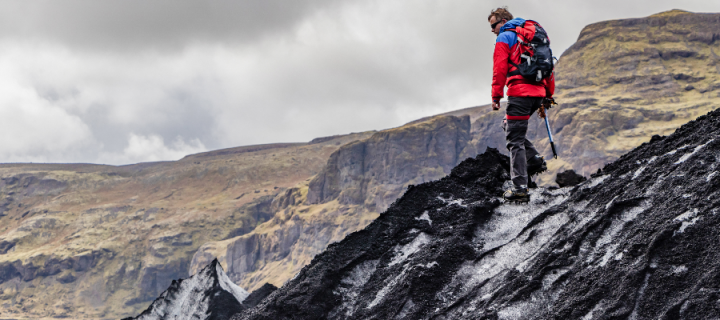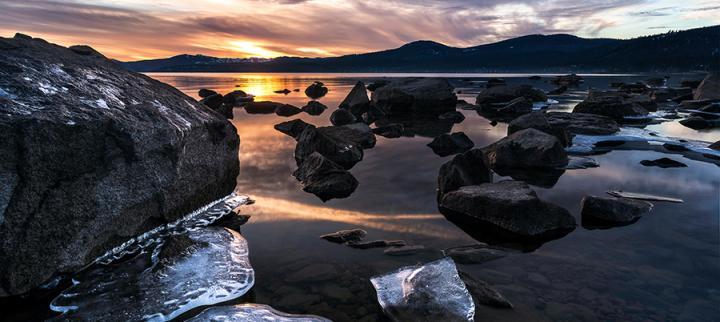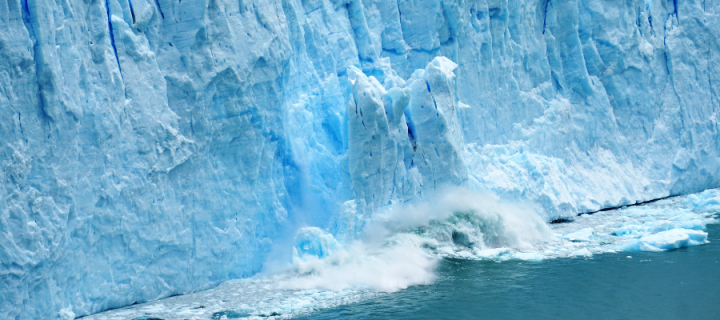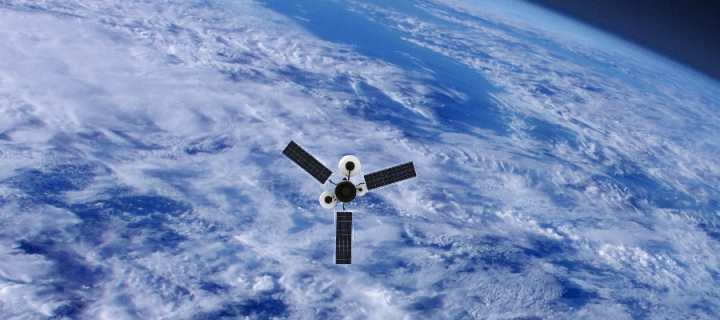Numerical-modelling of ice-sheet and glacier melting
We have spearheaded methods to collect invaluable field data and developed new computer modelling techniques to monitor and predict changes in the Earth's ice-covered regions. Our work is providing key input to climate change decision-making worldwide.

Changes taking place in the Arctic, Antarctic and other glaciated regions are drivers for disruptive global changes, especially sea-level rise, with major ramifications for people living not only in polar regions but worldwide.
Our researchers have developed new computer modelling techniques that determined oceans' impact on the flow and retreat of ice around West Antarctica and Greenland.
As a result, our equations have greatly improved predictions of the Antarctic Ice Sheet's fate and its contribution to global sea-level rise over the next 200 years.
Our efforts to measure the landscape accurate to metres, not kilometres, mean we now have a much more detailed understanding of how the landscape under the ice changes how it moves and melts.
We are among the world-leading scientists who have made crucial contributions to the Intergovernmental Panel on Climate Change (IPCC) Assessment Reports. These are the most comprehensive scientific reports about climate change produced worldwide.
Highlights
You can find out key information by clicking on each heading below:

New computer modelling techniques
The British Antarctic Survey (BAS) is an institute of the Natural Environment Research Council NERC). It delivers and enables world-leading interdisciplinary research in the Polar Regions. BAS is the focal point for UK Antarctic research and operations. International collaboration and co-operation are essential to achieve a co-ordinated research effort.
The BAS included a GBP2,4000,000 funded numerical-modelling programme dedicated to greatly improved predictions of the Antarctic Ice Sheet's fate and its contribution to global sea-level rise over the next 200 years.
This programme has been underpinned by geophysical measurements of the shape and condition of Antarctica's ice-sheet bed, led by our researchers who acquired and processed data into subglacial topographic maps. Numerical-modelling equations and strategies developed at our University have contributed to greatly reduced uncertainties in the BAS programme for numerically modelling the future of the ice sheets.
Climate change policies
National and international policies, including the UK national policy on mitigating sea-level rise is informed by the Intergovernmental Panel on Climate Change (IPCC). The IPCC Reports are the formal scientific input to the decision-making processes of international climate change negotiations and agreements, including the United Nations Paris Agreement.
In turn, the IPCC is informed by major national programmes such as the British Antarctic Survey.
BAS contributions to IPCC have been underpinned by our researchers' work. Our field data acquired from the deep interior of Antarctica have been critical to constraining British Antarctic Survey models of future ice retreat from Antarctica and its consequent contributions to global sea-level rise. Numerical modelling strategies developed by our scientists have also informed us about the impact of oceans on the flow and retreat of ice around West Antarctica and Greenland and have also demonstrated the important role that climate variability plays in the ice-ocean system.
For example, the 2019 IPCC Special Report 'Ocean and Cryosphere in a Changing Climate' cited numerous papers by our researchers. These regions were highlighted in the Summary for Policymakers as key sources of future sea-level rise. In addition, the numerical tools developed for the studies have proven key components of wider community efforts to project West Antarctica's future.
Recently, our work with the BAS has supported the sea-level rise assessments for the IPCC 6th assessment reports and used as the primary evidence bases for global policymakers in planning sea-level defences.
You can find out more about the British Antarctic Survey on their website.

The Intergovernmental Panel on Climate Change (IPCC) is the leading international body for assessing climate change.
Every five to seven years, the IPCC produces Assessment Reports. These are the most comprehensive scientific reports about climate change produced worldwide. Between the Assessment Reports, the IPCC also publishes Special Reports which focus on a specific issue.
The IPCC is now producing the Sixth Assessment Report (AR6) with contributions by its three Working Groups. The first instalment of the report by Working Group I (WGI) – the Physical Science Basis was released in August 2021.
Our contributions to the reports
Our research has made significant contributions to the IPCC Assessment Reports and the Special Reports, guiding policies around the world.
Our new computer modelling techniques have helped determine oceans' impact on the flow and retreat of ice around West Antarctica and Greenland. As a result, our equations have greatly improved predictions of the Antarctic Ice Sheet's fate and its contribution to global sea-level rise over the next 200 years.
Find out more:
University impact
You can also read related stories on the University Impact website:
|
Signals from a drowning world Melting ice sheets and glaciers are a startling reminder of the rate of climate change. However, measuring ice loss was an inaccurate science... until Edinburgh experts helped change things. |
Signals from a drowning world |

Our researchers have also been recently working through the International Thwaites Glacier Collaboration.
The largest Earth science funding agencies in the United Kingdom and the United States are collaborating to investigate one of the most unstable glaciers in Antarctica. The US National Science Foundation (NSF) and the UK Natural Environment Research Council (NERC) are teaming up to study a rapidly changing glacier roughly the same size as Florida or Britain.
The NERC and NSF partnership, called the International Thwaites Glacier Collaboration (ITGC), covers research across Thwaites Glacier and its adjacent ocean region; the glacier flows into Pine Island Bay, part of the Amundsen Sea. ITGC is the largest joint UK-US project undertaken on the southern continent in 70 years.
The International Thwaites Glacier Collaboration is also informing the Intergovernmental Panel on Climate Change (IPCC) reports.
You can find out more about the collaboration on the ITGC website.

We are also conducting world-leading research that has improved the spatial and temporal resolution for satellite monitoring of changing ice sheets and glaciers. Satellite observations gathered over glaciers worldwide have been critical to substantially improving estimates of the rates of ice loss and quantifying their contribution to sea-level rise.
We developed new data analytic methods from satellite observations, providing greater insight into terrains. We can also better pinpoint where the ocean is eroding ice under the melting Antarctic ice shelves.
For example, our work with organisations such as the European Space Agency has shown that Greenland today is losing ice seven times faster than two decades ago.
You can read about our work with the European Space Agency within the pages of this website.
Satellite observations of ice-sheet and glacier melting
Want to know more?
We've provided some useful links for you. To see the information, simply click on each heading below:
Study with us, and join one of the largest and most successful groupings of geographers and geoscientists in the UK as we address the most compelling issues of our time.
The following degrees may be of interest to you:
Undergraduate study
Postgraduate study
Postgraduate research
Check out more of our diverse undergraduate, postgraduate and research degrees and help us change the world.
Research groups
|
Cryosphere The Cryosphere research group combines field, satellite remote sensing, geophysical, geochronological and numerical modelling techniques to investigate how the cryosphere will be affected by predicted climate change, and to inform possible consequences on our society with respect to sea-level rise and water resources. |
Visit the Cryosphere research group |
|
Land Surface Dynamics The Land Surface Dynamics research group is focused on determining the Earth surface response to climatic and tectonic forcing in terms of erosional and sedimentary fluxes and the consequent geomorphology of the continents. |
Visit the Land Surface Dynamics research group |
Research institutes
Our research is carried out across our three interdisciplinary research institutes. There are also a number of research groups within each institute. Due to the interdisciplinary nature of our research, academic staff may belong to one or more groups across the institutes.
| Earth and Planetary Sciences Institute | Global Change Institute | Geography and the Lived Environment Institute |
External centres and networks
Our research enables people from different institutes within the School, other departments within the University as well as external partners and organisations to work together to address local and global challenges.
We've provided more information on our work and the role of the IPCC:
You can also read related stories on the University Impact website:
|
Signals from a drowning world Melting ice sheets and glaciers are a startling reminder of the rate of climate change. However, measuring ice loss was an inaccurate science... until Edinburgh experts helped change things. |
Signals from a drowning world |

